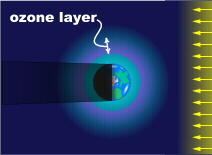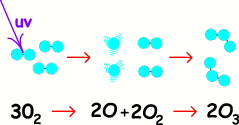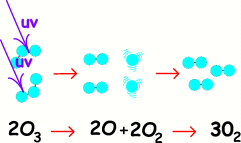|
One of the primary objectives of the SCISAT-1, ACE (Atmospheric Chemistry Experiment) mission is to monitor the Earth’s ozone layer, especially at high latitudes. This is of special importance to Canadians. The Earth is surrounded by a thin layer of gases made up of a mixture of molecules. These are mostly molecules of nitrogen, oxygen, argon and carbon dioxide. This thin layer we call the Earth’s atmosphere.
One very important molecule, which occurs at high altitudes in the Earth’s atmosphere is ozone. The region of the Earth’s atmosphere containing ozone is often referred to as the ozone layer even though it comprises a very small portion of the molecular composition in that region. The diagram above illustrates how the ozone layer surrounds the Earth in a zone high in the Earth’s atmosphere. The abundance of ozone gradually increases as one moves upwards through the Earth’s atmosphere, reaching a maximum abundance at an altitude of about 30km, and then gradually decreasing as one moves further upwards in through the atmosphere. The Formation of Ozone
The Importance of Ozone
|


